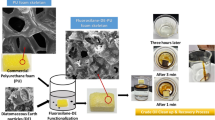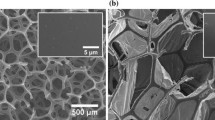Abstract
The release of oil and organic pollutants into water bodies poses a severe environmental concern because they bioaccumulate and are difficult to degrade. In this study, an alternative polyurethane (PU) composite foam containing hydroxylated multi-walled carbon nanotubes (MWCNTs) and polydimethylsiloxane (PDMS) was prepared using a dip-coating method. Adding MWCNTs and PDMS transformed the hydrophilic pristine PU foam to a superhydrophobic PU/CNT-PDMS, as evidenced by the substantial increase in the water contact angle value. Our work evaluated the performance of the foams containing different MWCNTs loading and PDMS concentrations in the oil-water separation process. The foam comprising of 6.97 wt% MWCNTs and 6.52 wt% PDMS, exhibited the highest absorption performance, with the maximum absorption capacity of 33.83 and 44.98 g/g for engine oil and acetone. The recyclability test showed that the PU/CNT-PDMS hybrid foam retained at least 90% of its initial oil absorption capacity after 10 absorption-desorption cycles. The PU/CNT-PDMS hybrid foam produced showed excellent absorption characteristics and was reusable, confirming its potential as a suitable candidate for efficiently removing oil and organic solvents from water.













Similar content being viewed by others
Data availability
Data can be made available on request from the authors.
References
P.S. Dhumal, R.V. Khose, P.H. Wadekar, K.D. Lokhande, S. Some, Graphene–Bentonite supported free-standing, flexible membrane with switchable wettability for selective oil–water separation. Sep. Purif. Technol. 266, 118569 (2021)
D.K. Kulal, R.V. Khose, D.A. Pethsangave, P.H. Wadekar, S. Some, Biomass-derived lignocellulosic graphene composite: novel approach for removal of oil and organic solvent. ChemistrySelect. 4, 4568–4574 (2019)
E. Piperopoulos, L. Calabrese, E. Mastronardo, E. Proverbio, C. Milone, Thermo-Physical characterization of Carbon Nanotube Composite Foam for Oil Recovery Applications. Nanomaterials. 10, 86 (2020)
X. He, S. Lin, X. Feng, Q. Pan, Synthesis and modification of polyurethane foam doped with multi-walled Carbon Nanotubes for Cleaning Up Spilled Oil from Water. J Polym. Environ. 29, 1271–1286 (2021)
A. Carpenter, Oil pollution in the North Sea: the impact of governance measures on oil pollution over several decades. Hydrobiologia. 845, 109–127 (2019)
S. Jamaly, A. Giwa, S.W. Hasan, Recent improvements in oily wastewater treatment: Progress, challenges, and future opportunities. J. Environ. Sci. 37, 15–30 (2015)
B. Doshi, M. Sillanpää, S. Kalliola, A review of bio-based materials for oil spill treatment. Water Res. 135, 262–277 (2018)
D.D. Evans, G.W. Mulholland, H.R. Baum, W.D. Walton, Mcgrattan, in situ burning of oil spills. J. Res. Natl. Inst. Stand. Technol. 106, 14 (2001)
M.A. Zahed, H.A. Aziz, M.H. Isa, L. Mohajeri, S. Mohajeri, Optimal conditions for bioremediation of oily seawater. Bioresour Technol. 101, 9455–9460 (2010)
T.R. Annunciado, T.H.D. Sydenstricker, S.C. Amico, Experimental investigation of various vegetable fibers as sorbent materials for oil spills. Mar. Pollut Bull. 50, 1340–1346 (2005)
J. Wang, Y. Zheng, A. Wang, Superhydrophobic kapok fiber oil-absorbent: Preparation and high oil absorbency. Chem. Eng. J. 213, 1–7 (2012)
U.C. Paul, D. Fragouli, I.S. Bayer, A. Athanassiou, Functionalized cellulose networks for efficient oil removal from oil–water emulsions. Polymers. 8, 52 (2016)
H. Liu, B. Geng, Y. Chen, H. Wang, Review on the aerogel-type oil sorbents derived from nanocellulose. ACS Sustain. Chem. Eng. 5, 49–66 (2017)
G. Guo, L. Liu, Z. Dang, W. Fang, Recent progress of polyurethane-based materials for oil/water separation. World Sci. Pub Co. 12, 1730001 (2017)
X. Zhang, D. Liu, Y. Ma, J. Nie, G. Sui, Super-hydrophobic graphene coated polyurethane (GN@PU) sponge with great oil-water separation performance. Appl. Surf. Sci. 422, 116–124 (2017)
E. Piperopoulos, L. Calabrese, E. Mastronardo, E. Proverbio, C. Milone, Synthesis of reusable silicone foam containing carbon nanotubes for oil spill remediation. J. Appl. Polymer Sci. 135, 14 (2018)
C.L. Yu, C.M. Yu, L. Cui, Z. Song, X. Zhao, Y. Ma, L. Jiang, Facile preparation of the porous PDMS oil-absorbent for oil/water separation. Adv. Mater. Interfaces. 4, 1600862 (2017)
H. Shamsijazeyi, C.A. Miller, M.S. Wong, J.M. Tour, R. Verduzco, Polymer-coated nanoparticles for enhanced oil recovery. J. Appl. Polym. Sci. (2014). https://doi.org/10.1002/app.40576
X. Ge, X. Men, Z. Zhu, A. Zhang, Superhydrophobic monolithic material with tunable wettability for oil and water separation. J. Mater. Sci. 50, 2365–2369 (2015)
K.V. Maheshkumar, K. Krishnamurthy, P. Sathishkumar, S. Sahoo, E. Uddin, S.K. Pal, R. Rajasekar, Research updates on graphene oxide-based polymeric nanocomposites. Polym. Compos. 35, 2297–2310 (2014)
D.W. Kim, K. Eum, H. Kim, D. Kim, M.D. de Mello, K. Park, Tsapatsis. Continuous ZIF-8/reduced graphene oxide nanocoating for ultrafast oil/water separation. Chem. Eng. J. 372, 509–515 (2019)
V. Nandwana, S.M. Ribet, R.D. Reis, Y. Kuang, Y. More, V.P. Dravid, O.H.M. Sponge, A versatile, efficient, and ecofriendly environmental remediation platform. Ind. Eng. Chem. Res. 59, 10945–10954 (2020)
T. Zhang, B. Gu, F. Qiu, X. Peng, X. Yue, D. Yang, Preparation of carbon nanotubes/Polyurethane hybrids as a synergistic absorbent for efficient oil/water separation. Fibers Polym. 19, 2195–2202 (2018)
M.T.M. Pendergast, E.M.V. Hoek, A review of water treatment membrane nanotechnologies. Energy Environ. Sci. 4, 1946–1971 (2011)
C. Xia, Y. Li, T. Fei, W. Gong, Facile one-pot synthesis of superhydrophobic reduced graphene oxide-coated polyurethane sponge at the presence of ethanol for oil-water separation. Chem. Eng. J. 345, 648–658 (2018)
S.M. Kong, Y. Han, N. Won, Yang, polyurethane sponge with a modified specific surface for repeatable oil – water separation. ACS Omega. 6, 33969–33975 (2021)
ASTM, Standard test methods for flexible cellular materials - slab, bonded, and molded urethane foams (2022). Available online: http://www.astm.org/Standards/D3574 (Accessed on 21st January 2022)
J. Pinto, E. Solorzano, M.A. Rodriguez-Perez, DeSaja, characterization of the cellular structure based on user-interactive image analysis procedures. J. Cell. Plast. 49, 555–575 (2013)
Z. Horak, K. Dvorak, L. Zarybnicka, H. Vojackova, J. Dvorakova, Vilimek, experimental measurements of mechanical properties of pur foam used for testing medical devices and instruments depending on temperature, density and strain rate. Materials. 13, 1–13 (2020)
H. Li, L. Liu, F. Yang, Hydrophobic modification of polyurethane foam for oil spill cleanup. Mar. Pollut Bull. 64, 1648–1653 (2012)
D. Wu, L. Fang, Y. Qin, W. Wu, C. Mao, H. Zhu, Oil sorbents with high sorption capacity, oil/water selectivity and reusability for oil spill cleanup. Mar. Pollut Bull. 84, 263–267 (2014)
A. Keshavarz, H. Zilouei, A. Abdolmaleki, A. Asadinezhad, Enhancing oil removal from water by immobilizing multi-wall carbon nanotubes on the surface of polyurethane foam. J. Environ. Mgt. 157, 279–286 (2015)
L. Calabrese, E. Piperopoulos, V.S. Jovanovic, V. Mitic, M. Mitic, C. Milone, Proverbio, oil spill remediation: selectivity, sorption, and squeezing capacity of silicone composite foams filled with clinoptilolite. J. Appl. Pol. Sci. 139, 29 (2022)
Z. Rahmani, M.T. Samadi, A. Kazemi, A.M. Rashidi, Rahmani, nano porous graphene and graphene oxide-coated polyurethane sponge as a highly efficient, superhydrophobic, and reusable oil spill absorbent. J. Environ. Chem. Eng. 5, 5025–5032 (2017)
J. Chang, Y. Shi, M. Wu, R. Li, L. Shi, Y. Jin, W. Qing, C. Tang, Wang, solar-assisted fast cleanup of heavy oil spills using a photothermal sponge. J. Mater. Chem. 6, 9192–9199 (2018)
Y. Wang, Y. Zhu, C. Zhang, J. Li, Guan, transparent, superhydrophobic surface with varied surface tension responsiveness in wettability based on tunable porous silica structure for gauging liquid surface tension. ACS Appl. Mater. Interfaces. 9, 4142–4150 (2017)
A. Mata, A.J. Fleischman, Roy, characterization of polydimethylsiloxane (PDMS) properties for biomedical micro/ nanosystems. Biomed. Microdevices. 7, 281–293 (2005)
Q. Shuai, X. Yang, Y. Luo, H. Tang, X. Luo, A superhydrophobic poly(dimethylsiloxane)-TiO2 coated polyurethane sponge for selective absorption of oil from water. Mater. Chem. And Phys. 162, 94–99 (2015)
Y. Peng, Z. Zheng, P. Sun, X. Wang, T. Zhang, Synthesis and characterization of polyphenol-based polyurethane. New. J. Chem. 37, 729 (2013)
J. Pinto, J.A. Heredia-Guerrero, A. Athanassiou, D. Fragouli, Reusable nanocomposite-coated polyurethane foams for the remediation of oil spills. Int. J. Environ. Sci. Technol. 14, 2055–2066 (2017)
S. Yang, L. Chen, S. Liu, W. Hou, J. Zhu, P. Zhao, Q. Zhang, Facile and sustainable fabrication of high-performance cellulose sponge from cotton for oil-in-water emulsion separation. J. of H MB 408, 124408 (2021)
J.M. Kim, J.H. Kim, Y. Choi, S. Park, K. Park, Effect of graphene oxide on polyurethane foam mechanical strength. J. Korean Soc. Of Mar. Eng. 40, 493–498 (2016)
P. Hou, S. Bai, Q. Yang, C. Liu, H. Cheng, Multi-step purification of carbon nanotubes. Carbon. 40, 81–85 (2002)
H. Wang, E. Wang, Z. Liu, D. Gao, R. Yuan, L. Sun, Y. Zhu, A novel carbon nanotubes reinforced superhydrophobic and superoleophilic polyurethane sponge for selective oil-water separation through a chemical fabrication. J. Mater. Chem. A 3, 266–273 (2014)
M. Khosravi, S. Azizian, Synthesis of a novel highly oleophilic and highly hydrophobic sponge for rapid oil spill cleanup. ACS Appl. Mater. Interfaces. 7, 25326–25333 (2015)
O. Oribayo, X. Feng, G.L. Rempel, Q. Pan, Synthesis of lignin-based polyurethane/ graphene oxide foam and its application as an absorbent for oil spill clean-ups and recovery. Chem. Eng. J. 323, 191–202 (2017)
L. Kong, Y. Li, F. Qiu, T. Zhang, Q. Guo, X. Zhang, D. Yang, J. Xu, M. Xue, Fabrication of hydrophobic and oleophilic polyurethane foam sponge modified with hydrophobic Al2O3 for oil/water separation. J. Ind. Eng. Chem. 58, 369–375 (2018)
Funding
This research received no external funding.
Author information
Authors and Affiliations
Contributions
Conceptualization, AHA and ISJ; methodology, JAK, AHA, ISJ, NZ and SNAMJ.; formal analysis, JAK and AHA; investigation, JAK.; resources, JAK and AH A; data curation, JAK and AHA; writing—original draft preparation, JAK.; writing—review and editing, AHA, ISJ, NZ and SNAMJ.; visualization, JAK; supervision, AHA, ISJ, NZ and SNAMJ; project administration, AHA, ISJ, NZ and SNAMJ. All authors have read and approved the final manuscript.
Corresponding author
Ethics declarations
Conflict of interest
The authors declare that they have no conflict of interests.
Additional information
Publisher’s Note
Springer Nature remains neutral with regard to jurisdictional claims in published maps and institutional affiliations.
Rights and permissions
Springer Nature or its licensor (e.g. a society or other partner) holds exclusive rights to this article under a publishing agreement with the author(s) or other rightsholder(s); author self-archiving of the accepted manuscript version of this article is solely governed by the terms of such publishing agreement and applicable law.
About this article
Cite this article
Kadili, J.A., Abdullah, A.H., Johari, I.S. et al. Highly efficient and reusable superhydrophobic 3D polyurethane nanocomposite foam for remediation of oil polluted water. J Porous Mater 31, 449–461 (2024). https://doi.org/10.1007/s10934-023-01529-w
Accepted:
Published:
Issue Date:
DOI: https://doi.org/10.1007/s10934-023-01529-w




